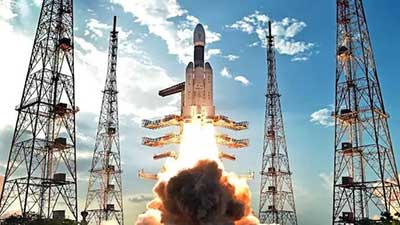Date: 06/03/2023
Relevance: GS-3: Science and Technology: Recent developments and their applications and effects in everyday life
Key Phrases: CE-20 Cryogenic Engine, ISRO Propulsion Complex, EMI/EMC, Spectro-apolarimetry of HAbitable Planet Earth (SHAPE) Payload, Chandra’s Surface Thermophysical Experiment (ChaSTE), Launch Vehicle Mark 3 (LVM3)
Why in News?
- The Indian Space Research Organisation (ISRO) has successfully conducted the flight acceptance hot test of the CE-20 cryogenic engine that will power the Cryogenic Upper Stage of the LVM3 launch vehicle for the Chandrayaan-3 mission.
Key Highlights:
- The hot test was carried out for a planned duration of 25 seconds at the High Altitude Test Facility of the ISRO Propulsion Complex at Mahendragiri in Tamil Nadu on February 24.
- All the propulsion parameters during the test were found satisfactory and closely matched with predictions.
- The cryogenic engine will be further integrated with the propellant tanks, stage structures and associated fluid lines to realise the fully-integrated flight cryogenic stage.
Earlier tests held:
- Chandrayaan-3 lander successfully underwent EMI/EMC test at U R Rao Satellite Centre.
- EMI-EMC (Electro-Magnetic Interference/Electro-Magnetic Compatibility) test is conducted for satellite missions to ensure the functionality of the satellite subsystems in the space environment and their compatibility with the expected electromagnetic levels.
- During the Chandrayaan-3 lander EMI/EC test, launcher compatibility, antenna polarisation of all RF systems, standalone auto compatibility tests for orbital and powered descent mission phases, and lander and rover compatibility tests for post landing mission phase were ensured.
Major Modules of Chandrayaan-3 Interplanetary Mission:
- The propulsion module
- The lander module
- A rover
Chandrayaan-3 Mission:
- Chandrayaan-3 is a follow-on mission to Chandrayaan-2 to demonstrate end-to-end capability in safe landing and roving on the lunar surface.
- It consists of Lander and Rover configuration.
- It will be launched by GSLV MkIII from SDSC, Sriharikota.
- The propulsion module will carry the lander and rover configuration till 100km lunar orbit.
- The propulsion module has Spectro-polarimetry of HAbitable Planet Earth (SHAPE) payload to study the spectral and polarimetric measurements of Earth from the lunar orbit.
- "Chandrayaan-3 consists of an indigenous Lander module (LM), Propulsion module (PM), and a Rover with the objective of developing and demonstrating new technologies required for Interplanetary missions.
- The Lander will have the capability to soft land at a specified lunar site and deploy the Rover which will carry out in-situ chemical analysis of the lunar surface during the course of its mobility.
- The Lander and the Rover have scientific payloads to carry out experiments on the lunar surface.
Lander Payloads:
- Chandra’s Surface Thermophysical Experiment (ChaSTE) to measure the thermal conductivity and temperature
- Instrument for Lunar Seismic Activity (ILSA) for measuring the seismicity around the landing site
- Langmuir Probe (LP) to estimate the plasma density and its variations
- A passive Laser Retroreflector Array from NASA is accommodated for lunar laser ranging studies.
Rover Payloads:
- Alpha Particle X-ray Spectrometer (APXS) and Laser Induced Breakdown Spectroscope (LIBS) for deriving the elemental composition in the vicinity of landing site.
Launch Vehicle Mark 3 (LVM3):
- The Launch Vehicle Mark 3 (LVM3) is ISRO’s newest medium-heavy lift launch vehicle, the heaviest rocket currently in use by the space agency.
- Formerly called the Geosynchronous Satellite Launch Vehicle Mark III (GSLV Mk III), the rocket is designed to mainly launch satellites into geostationary orbit at 35,000km.
- The LVM3 will go everywhere —GEO, MEO, LEO as well as missions to the moon as against only to a specific orbit.
- The LVM3 is capable of lifting much heavier satellites than the GSLV Mk II with a bigger cryogenic upper stage and a larger first stage.
- Both GSLV Mk II and LVM3 are three-stage vehicles, while the PSLV, which launches to low earth polar orbits, is a four-stage vehicle.
- The GSLV Mk-II can place up to 2,500kg in geosynchronous orbits and up to 5,000kg in low earth orbit. By comparison, the LVM3 can lift 4,000kg to GTO and up to 8,000 kg to LEO.
- Currently, SpaceX’s non-human rated Falcon Heavy, a super-heavy lift vehicle, is the heaviest rocket that is operational, only surpassed by the retired Saturn V, which launched Apollo astronauts to the moon.
- The LVM3 also has the human-rated variant which will be used for Gaganyaan missions.
What will Chandrayaan-3 do on the Moon?
- The mission is aimed at better understanding the Moon's composition.
- ISRO has laid out three main objectives for the mission, which include
- Demonstrating a safe and soft landing on the lunar surface
- Demonstrating the rover's roving capabilities on the moon
- Performing in-situ scientific observations.
- The mission's Chandra Surface Thermophysical Experiment (ChaSTE) will measure the thermal conductivity and temperature, while the Instrument for Lunar Seismic Activity (ILSA) will measure the seismicity around the landing site.
- The Langmuir Probe (LP) will estimate the plasma density and its variations and a passive Laser Retroreflector Array from NASA is accommodated on the mission for lunar laser ranging studies.
Reasons For Targeting Lunar South Pole of the Moon For Exploration?
- The best connection to Earth's early history and civilization is made by the Moon.
- The exploration will provide an unaltered historical record of the conditions in the inner Solar System.
- The shadow-covered portion of the lunar surface at the South Pole is significantly bigger than at the North Pole, which makes it particularly interesting.
- In addition, places around it that are always in the shadows can have the possibility of presence of water.
- A fossil record of the early Solar System can also be found in cold trap craters near the South Pole.
Source: The Hindu BL
Mains Question:
Q. Highlight the mission objectives of Chandrayaan-3 mission as well as its significance for India. (250 words).






















